

Grief and Loss. Natural/Alternative Healing etc. 10 Little Habits that Steal Your Happiness. 1.
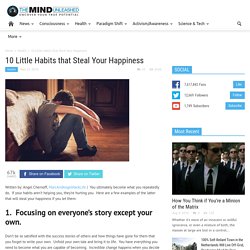
Focusing on everyone’s story except your own. Don’t be so satisfied with the success stories of others and how things have gone for them that you forget to write your own. Unfold your own tale and bring it to life. You have everything you need to become what you are capable of becoming. Incredible change happens when you decide to take control. If you want your life story to soar to new heights, you’ve got to clear a path, reduce the time-sinks and burdens weighing you down, and pick up the things that give you wings. 2. Don’t buy into the myth of the perfect moment. Your ability to grow to your highest potential is directly related to your willingness to act in the face of imperfection. 3. 13 things mentally strong people don’t do. Mentally strong people have healthy habits.
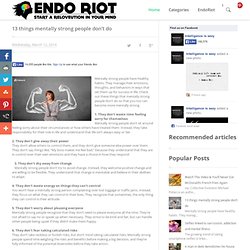
They manage their emotions, thoughts, and behaviors in ways that set them up for success in life. How Do You Manage Emotional Pain? Take the Pain-Body Quiz to Find Out. In Eckhart Tolle’s opinion, emotion is the body’s reaction to a certain idea, to the mental interpretation of a specific or imaginary situation.
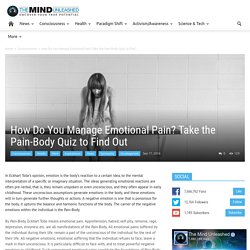
The ideas generating emotional reactions are often pre-verbal, that is, they remain unspoken or even unconscious, and they often appear in early childhood. These unconscious assumptions generate emotions in the body, and these emotions will in turn generate further thoughts or actions. A negative emotion is one that is poisonous for the body, it upturns the balance and harmonic functions of the body.
The carrier of the negative emotions within the individual is the Pain-Body. By Pain-Body, Eckhart Tolle means emotional pain. If you’re ready to understand the nature, structure and dynamics of your Pain-Body, so that you may begin to heal it, all you have to do is to complete the following Pain-Body Quiz. The Pain-Body Quiz is assembled according to the strict criteria of the development of a scientific research method.
Take the Pain-Body Quiz. What it Really Means to Hold Space for Someone. When my Mom was dying, my siblings and I gathered to be with her in her final days.
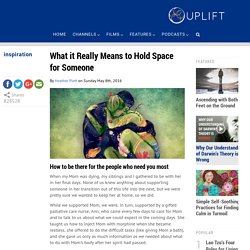
None of us knew anything about supporting someone in her transition out of this life into the next, but we were pretty sure we wanted to keep her at home, so we did. While we supported Mom, we were, in turn, supported by a gifted palliative care nurse, Ann, who came every few days to care for Mom and to talk to us about what we could expect in the coming days. She taught us how to inject Mom with morphine when she became restless, she offered to do the difficult tasks (like giving Mom a bath), and she gave us only as much information as we needed about what to do with Mom’s body after her spirit had passed.
The author with her mother “Take your time,” she said. Ann gave us an incredible gift in those final days. In the two years since then, I’ve often thought about Ann and the important role she played in our lives. Learning to hold space for others What does it mean to “hold space” for someone else? 1. Wilhelm Reich’s Armoring. Reich's Segmental Armouring Theory - Energetics Institute. Wilhelm Reich was a major contributor to the bodymind sciences of the early 20th century, and is credited as being the key driver of this form of scientific enquiry in the West up until the 1940’s.
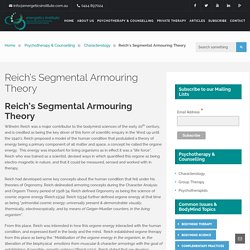
Reich proposed a model of the human condition that postulated a theory of energy being a primary component of all matter and space, a concept he called the orgone energy. This energy was important for living organisms as in effect it was a “life force”. Reich who was trained as a scientist, devised ways in which quantified this orgone as being electro-magnetic in nature, and that it could be measured, sensed and worked with in therapy. Reich had developed some key concepts about the human condition that fell under his theories of Orgonomy. Reich delineated armoring concepts during the Character Analysis and Orgasm Theory period of 1928-34. From this place, Reich was interested in how this orgone energy interacted with the human condition, and expressed itself in the body and the mind. An Indigenous Approach to Healing Trauma. People have always experienced pain, and in the vast span of time before the colonial expansion of western culture, indigenous cultures weren’t without their methods of dealing with trauma.
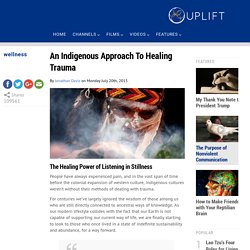
For centuries we’ve largely ignored the wisdom of those among us who are still directly connected to ancestral ways of knowledge. As our modern lifestyle collides with the fact that our Earth is not capable of supporting our current way of life, we are finally starting to look to those who once lived in a state of indefinite sustainability and abundance, for a way forward. “In order to have sustainable community you have to make sure the people are sustainable. This means healing trauma.” – Jarmbi Githabul, Narakwal / Githabul Custodian What is Dadirri? “Dadirri is inner, deep listening and quiet, still awareness. When Miriam-Rose Ungunmerr-Baumann speaks of dadirri, she speaks of a form of deep, contemplative listening that is nothing less than a personal spiritual practice.
Emotional Completion. Traumaverwerking. Lees meer over: Tips : Pot gevoelens niet op, maar uit ze.
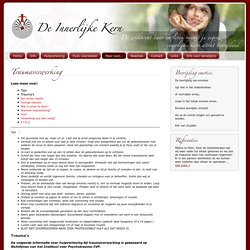
Laat ook je privé-omgeving delen in je verdriet.Vermijd niet om te praten over wat je hebt ervaren.